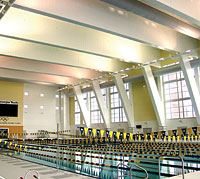
Olympian Feat
The 13,300-square-foot pool, which is the former outdoor pool built for the 1996 Summer Olympics held in Atlanta, serves as the anchor for Georgia Tech's ambitious $45 million, 289,000-square-foot Campus Recreation Center that surrounds it.The 100,000-square-foot Aquatic Center that encloses this mammoth competition pool presented a host of HVAC design challenges for the project team at design-build mechanical contractor Lee Co., Franklin, Tenn., and architect Hastings + Chivetta Architects, St. Louis.
The original 1.5-million-gallon pools' freestanding, 115-foot-high rain-sun shelter and rooftop photovoltaic cells were to remain as part of a 25-year research study grant conducted by the university, Georgia Power, and the U.S. Department of Energy. The solar system now provides 30 percent of the building's power.
It was Hastings + Chivetta's difficult task not only to design walls and enclose the structure, but to cost effectively add 50,000 square feet of athletic activity spaces in the void between the canopy and pool, which was created by removing 13,000 of the 15,000 spectator seats temporarily installed for the Olympics.
Hastings + Chivetta's design uses post-tension concrete - a standard in bridge building - to construct ten 58-foot-high arches that create the largest columnless indoor span in the country. The arches serve both as a natatorium ceiling and floor for upper-level athletic areas.
The initial design surpassed Georgia Tech's budget, and several contractors were required to value engineer the project. Lee Co. did its share of value engineering and cut the project's HVAC and plumbing budget by several hundred thousand dollars, according to Michael Saunders of Lee Co. The redesign specified fabric air dispersion duct. In the building's fourth-floor gyms, fabric duct also was threaded through bow trusses and branched out for complete floor coverage.

Duct Installation
Sedona fabric duct with Comfort-Flow air dispersion and linear vents manufactured by DuctSox, Dubuque, Iowa, helped cut both material and installation costs. Gray 56-inch-diameter fabric duct distributes dry, conditioned air along a wall of exterior windows and three 36-inch-diameter ceiling-hung branches span the entire width of the pool surface.A separate duct run supplies the spectator seating. The duct lengths hanging 50 feet over the pool feature DuctSox's Sonic Vent technology at three custom manufactured positions of 1 o'clock, 5 o'clock, and 11 o'clock to distribute air evenly while avoiding deflection against the 13-foot-deep ceiling joists between which they run.
"The trick was to get high enough velocity from the fabric duct, but not so much that unnecessary evaporation is caused at the pool surface level," Saunders noted. "In the case of Georgia Tech, we like the balance we've achieved."
In addition to saving material and labor costs, fabric duct does not require interior insulation and exterior epoxy coatings to prevent condensation and corrosion, which can be a problem in natatorium environments. "Fabric duct offers a bonus over metal in natatorium environments because pool chemicals do not degrade polyester fabric material," said Saunders.
The natatorium's HVAC design also saved equipment costs be-cause portions tap into the university steam loop instead of relying on expensive dehumidification equipment options that provide heating and cooling.
For example, cooling and dehumidifying the 2,000-seat spectator area is handled with a conventional chilled-water air-handling unit, consisting of one Model MCC-100 by Trane Co., Tyler, Texas. The chilled water is supplied by the building's 950-ton chiller, manufactured by York International, York, Pa. The complex's 2,850-gpm cooling tower was made by Evapco Inc., Westminster, Md.

Dehumidification
For the larger dehumidification loads of the pool, windows, and diving areas, Saunders used three dehumidifiers from Desert Aire Corp., Milwaukee. The two SA-60 and one ND-60 units each provide 26,000 cfm of dehumidified air for the windows, pool, and diving areas, along with a 50,000-cfm unit to serve the spectator area in the dehumidification process. Nearly 20 percent of outdoor air makes up the total cfm as calculated by the natatorium standard of 0.15 cfm per square foot.To eliminate chloromine-laden air that tends to linger above pool surfaces - a long-standing swimmer complaint at many competition pools - Saunders specified seven 3,500-cfm and two Loren Cook Co., Springfield, Mo., 16,000-cfm, deck-level exhaust fans.
To prevent air stratification within the voids between the 56-foot-high cast concrete joists not occupied by ducts, Saunders specified eight 22,000-cfm cross-ventilation fans that are controlled by variable-speed drives, in the event a televised swimming meet requires quieter ambient conditions.
While heating is rarely needed in Atlanta's warm climate, the natatorium can be heated on cold winter days via a 12-MBtu Taco Inc., Cranston, R.I., heat exchanger that converts campus steam to hot water to supply the air handlers. Additional heat is mixed through the dehumidifiers' systems, and the accompanying fabric duct is monitored by the campus-wide Johnson Controls' Metasys system.
In addition to saving money in labor and materials, Georgia Tech's maintenance department has a cost-effective option of retracting the DuctSox on its H-Track suspension system and laundering it.
Publication date: 10/25/2004

Report Abusive Comment